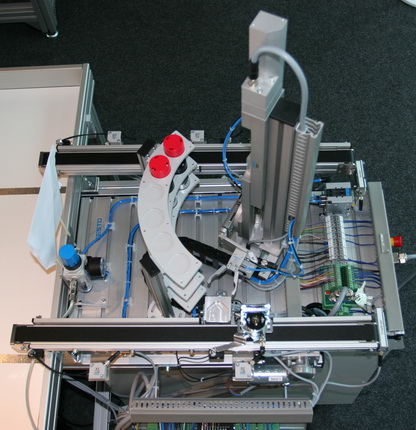| Type |
BA, DA, MA |
| Supervisor |
Prof. Dr.-Ing. Alois Knoll |
| Advisor |
Dipl.-Inf. Stephan Sommer |
| Research Area |
Embedded Systems, Sensor Networks |
| Programming Language |
JAVA |
| Language |
English or German |
Description
Sensor networks are denoted, on one hand, by their low prices, what enables their deployment in many new application areas, on the other hand, by constrained resources in terms of computation capacity, memory, battery supply etc. That is why most of the sensor networks are implemented application specific in contrast to general-purpose large scale networks such as the Internet.
A possible way to abstract from the concrete implementation is to use the service-oriented paradigm. Based on this approach, the sensor/actuator network is interpreted as a set of interacting services. The concrete implementation is abstracted and can be generated automatically. In general, there are nodes to sense (sensors), to act (actuators) and to perform required processing, so called in-network-processing, in such a network. Although the nodes might be heterogeneous, they are still resource constrained. That means it is not feasible to outsource all the processing into one single node. Rather it is reasonable to do some load balancing, i.e. to split the task into sub-task (sub-services) and let them work on different nodes. Thereby, the important issue is communication between the sub-services. The task placement must guarantee minimal resource consumption. If tasks are mapped to nodes which only provide a low connectivity, it might bring undesirable latencies.

The most important questions in this context are the following:
- How to decompose a service?
- How to map sub-services into sensor networks?
One could imagine a big range of new applications emerging e.g. for monitoring some phenomena or for performing distributed measurements over a long time. In this thesis, a scenario for industry automation will be considered.
The results of this thesis will be used in the
Multifunk project.
For more information to this topic, please contact
Stephan Sommer
Literature
- Andreas Scholz, Stephan Sommer, Christian Buckl, Gerd Kainz, Alfons Kemper, Alois Knoll, Jörg Heuer, and Anton Schmitt. Towards and adaptive execution of applications in heterogeneous embedded networks. In Software Engineering for Sensor Network Applications (SESENA 2010). ACM/IEEE, May 2010.
- Stephan Sommer, Christian Buckl, Gerd Kainz, Andreas Scholz, Irina Gaponova, Alois Knoll, Alfons Kemper, Jörg Heuer, and Anton Schmitt. Service migration scenarios for embedded networks. In The Fifth International Workshop on Service Oriented Architectures in Converging Networked Environments (SOCNE 2010). IEEE, April 2010.
- Adaptive distributed applications on heterogeneous networks
